Tatarstan
Republic of Tatarstan
| |
|---|---|
| Anthem: Государственный гимн Республики Татарстан (Russian) Татарстан Җөмһүрияте Дәүләт гимны (Tatar) "State Anthem of the Republic of Tatarstan"[2] | |
 | |
| Coordinates: 55°33′N 50°56′E / 55.550°N 50.933°E | |
| Country | Russia |
| Federal District[1] | Volga |
| Economic Region[3] | Volga |
| Capital | Kazan[4] |
| Government | |
| • Type | State Council[5] |
| • Head | Rustam Minnikhanov[6] |
| Area | |
| • Total | 67,847 km2 (26,196 sq mi) |
| Population | |
| • Total | |
| • Rank | 8th |
| • Density | 59.03/km2 (152.9/sq mi) |
| • Urban | 76.8% |
| • Rural | 23.2% |
| Demonym | Tatar |
| Time zone | UTC+3 (MSK[9]) |
| ISO 3166 code | RU-TA |
| Vehicle registration | 16, 116, 716 |
| Official language(s) | Tatar[10] • Russian[11] |
| Website | tatarstan.ru |
Tatarstan,[a] officially the Republic of Tatarstan,[b] sometimes also called Tataria,[c] is a republic of Russia located in Eastern Europe. It is a part of the Volga Federal District; and its capital and largest city is Kazan, an important cultural centre in Russia. The region's main source of wealth is oil with a strong petrochemical industry.
The republic borders the oblasts of Kirov, Ulyanovsk, Samara and Orenburg, as well as the republics of Mari El, Udmurtia, Chuvashia and Bashkortostan. The area of the republic is 68,000 square kilometres (26,000 sq mi), occupying 0.4% of the total surface of the country.[15] As of the 2021 Census, the population of Tatarstan was 4,004,809.[8]
Tatarstan has strong cultural, linguistic and ethnic ties with its eastern neighbour, Bashkortostan, which is also a republic of Russia.[16][17]
The official languages of the republic are Tatar and Russian.[18]
Etymology
[edit]"Tatarstan" derives from the name of the ethnic group—the Tatars—and the Persian suffix -stan (meaning "state" or "country" of, an ending common to many Eurasian countries). Another version of the Russian name is "Татария" (Tataria), which was official along with "Tatar ASSR" during Soviet rule.
Geography
[edit]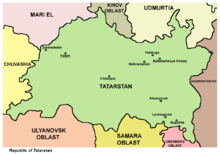
The republic is located in the centre of the East European Plain, approximately 800 kilometres (500 mi) east of Moscow. It lies between the Volga River and the Kama River (a tributary of the Volga), and extends east to the Ural Mountains.
Oak is the dominant tree species on 87% of the total area, followed by aspen, linden, birch, and Scots pine. The total forest cover has decreased from 51.2% to 17.1% over the last 300 years.[15]
The Volga-Kama Nature Reserve is situated in Tatarstan.
Borders
[edit]- Neighbours: Kirov Oblast (N), Udmurt Republic (N/NE), Republic of Bashkortostan (E/SE), Orenburg Oblast (SE), Samara Oblast (S), Ulyanovsk Oblast (S/SW), Chuvash Republic (W), Mari El Republic (W/NW).
- Highest point: 381 m (1,250 ft)[19]
- Maximum N–S distance: 290 km (180 mi)
- Maximum E–W distance: 460 km (290 mi)
Rivers
[edit]
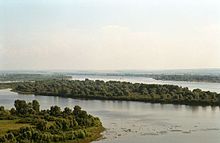

Major rivers include:
Lakes
[edit]Major reservoirs of the republic include:
The biggest lake is Kaban. The biggest swamp is Kulyagash.
Hills
[edit]Basins
[edit]Natural resources
[edit]The major natural resources of Tatarstan include oil, natural gas and gypsum. It is estimated that the republic has over one billion tons of oil deposits.[21]
Climate
[edit]- Average January temperature: −15 °C (5 °F)
- Average July temperature: +18 °C (64 °F)
- Average annual temperature: +4 °C (39 °F)
- Average annual precipitation: up to 500 to 550 mm (20 to 22 in)
Administrative divisions
[edit]Tatarstan's administrative and territorial divisions form 43 municipal districts and 2 urban districts (Kazan and Naberezhnye Chelny), as well as 39 urban settlements and 872 rural settlements. The republic also recognises cities of republican significance, the list of which is established by the Constitution of the Republic of Tatarstan. The districts consist of cities of district significance, urban-type settlements and rural settlements with subordinate territories that make up the primary level in the system of administrative-territorial structure of the Republic. Cities of national significance can be geographically divided into districts in the city.
History
[edit]This section needs additional citations for verification. (February 2011) |
| History of Tatarstan |
|---|
 |
Middle Ages
[edit]The earliest known organised state within the boundaries of Tatarstan was Volga Bulgaria (c. 700–1238). The Volga Bulgars had an advanced mercantile state with trade contacts throughout Inner Eurasia, the Middle East, and the Baltic, which maintained its independence despite pressure by such nations as the Khazars, the Kievan Rus, and the Cuman-Kipchaks. Islam was introduced by missionaries from Baghdad around the time of Ibn Fadlan's journey in 922.
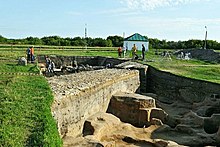
Volga Bulgaria finally fell to the armies of the Mongol prince Batu Khan in the late 1230s (see Mongol invasion of Volga Bulgaria). The inhabitants, a large amount of them killed and the rest mixing with the Golden Horde's Kipchaks, became known as the Volga Tatars. In the 1430s, the region again became independent as the base of the Khanate of Kazan, a capital having been established in Kazan, 170 km (110 mi) up the Volga from the ruined capital of the Bulgars.
The Khanate of Kazan was conquered by the troops of Tsar Ivan the Terrible in the 1550s, with Kazan being taken in 1552. A large number of Tatars were forcibly converted to Christianity and were culturally Russified.[22] Cathedrals were built in Kazan; by 1593 all mosques in the area were destroyed. The Russian government forbade the construction of mosques, a prohibition that was not lifted until the 18th century by Catherine the Great. The first mosque to be rebuilt under Catherine's auspices was constructed in 1766–1770.
19th century
[edit]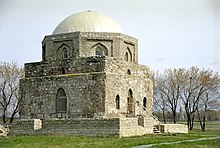
In the 19th century, Tatarstan became a centre of Jadidism, an Islamic movement that preached tolerance of other religions. Under the influence of local Jadidist theologians, the Bulgars were renowned for their friendly relations with other peoples of the Russian Empire. However, after the October Revolution religion was largely outlawed and all theologians were repressed.
20th century
[edit]During the Civil War of 1918–1920 Tatar nationalists attempted to establish an independent republic (the Idel-Ural State, Idel being the name of the Volga in Tatar) along with the neighbouring Bashkirs. Initially supported by the Bolsheviks, the state existed up until March 1918, when high-ranking members of its parliament were arrested by the Bolsheviks (who had turned on the state and denounced it as bourgeois) before the official declaration of its constitution. The Soviets later set up the Tatar Autonomous Soviet Socialist Republic, which was established on 27 May 1920.[23] The boundaries of the republic did not include a majority of the Volga Tatars. The Tatar Union of the Godless were persecuted in Joseph Stalin's 1928 purges.

A famine occurred in the Tatar Autonomous Soviet Socialist Republic in 1921–1922 as a result of the policy of war communism. The famine deaths of between 500,000 and 2 million Tatars in the Tatar ASSR and in the Volga-Ural region in 1921–1922 was catastrophic as half of the Volga Tatar population in the USSR died.[24]
Starting in the 1960s, schools opened in Tatarstan that taught Russian as an official second language, as it was necessary in order to individually advance in the broader Soviet society. By the 1980s, few schools still taught the Tatar language.[25]
Present day
[edit]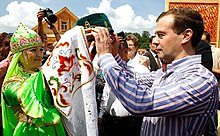
On 30 August 1990, Tatarstan declared its sovereignty with the Declaration on the State Sovereignty of the Tatar Soviet Socialist Republic[26] and in 1992 Tatarstan held a referendum on the new constitution,[27] promoted by Tatarstan's President Shaymiyev and supervised by Helsinki Commission staff. Parliament opposition revolved around the Russian faction Narodovlastie (People's Power).[28] Some 62% of those who took part voted in favour of the constitution, with ethnic Tatars supporting it much more than Russians.[28] In the new constitution, Tatarstan is defined as a Sovereign State. However, the referendum and constitution were declared unconstitutional by the Russian Constitutional Court.[29] Articles 1 and 3 of the Constitution as introduced in 2002[27] define Tatarstan as a part of the Russian Federation, removing the "sovereignty" term.
On 15 February 1994, the Treaty On Delimitation of Jurisdictional Subjects and Mutual Delegation of Authority between the State Bodies of the Russian Federation and the State Bodies of the Republic of Tatarstan[30] and Agreement between the Government of the Russian Federation and the Government of the Republic of Tatarstan (On Delimitation of Authority in the Sphere of Foreign Economic Relations) were signed. The power-sharing agreement was renewed on 11 July 2007, though with much of the power delegated to Tatarstan reduced.[31]
On 20 December 2008, in response to Russia recognising Abkhazia and South Ossetia, the Mejlis of the Crimean Tatar People organisation declared Tatarstan independent and asked for United Nations recognition.[32] However, this declaration was ignored both by the United Nations and the Russian government. On 24 July 2017, the autonomy agreement signed in 1994 between Moscow and Kazan expired, making Tatarstan the last republic of Russia to lose its special status.[33]
Demographics
[edit]Population: 4,004,809 (2021 Census);[8] 3,786,488 (2010 Census);[34] 3,779,265 (2002 Census);[35] 3,637,809 (1989 Soviet census).[36]
Settlements
[edit]Largest cities or towns in Tatarstan
2021 Russian Census | |||||||||
|---|---|---|---|---|---|---|---|---|---|
| Rank | Administrative Division | Pop. | |||||||
 Kazan  Naberezhnye Chelny |
1 | Kazan | City of republic significance of Kazan | 1,308,660 |  Nizhnekamsk  Zelenodolsk | ||||
| 2 | Naberezhnye Chelny | Tukayevsky District | 548,434 | ||||||
| 3 | Nizhnekamsk | Nizhnekamsky District | 241,479 | ||||||
| 4 | Zelenodolsk | Zelenodolsky District | 163,512 | ||||||
| 5 | Almetyevsk | Almetyevsky District | 100,000 | ||||||
| 6 | Bugulma | Bugulminsky District | 81,677 | ||||||
| 7 | Yelabuga | Yelabuzhsky District | 73,630 | ||||||
| 8 | Leninogorsk | Leninogorsky District | 60,993 | ||||||
| 9 | Chistopol | Chistopolsky District | 58,815 | ||||||
| 10 | Aznakayevo | Aznakayevsky District | 40,739 | ||||||
Vital statistics
[edit]

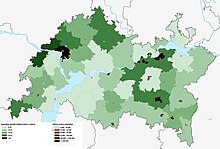



| Average population (1000s) | Live births | Deaths | Natural change | Crude birth rate (per 1000) | Crude death rate (per 1000) | Natural change (per 1000) | Fertility rates | |
|---|---|---|---|---|---|---|---|---|
| 1970 | 3,146 | 47,817 | 25,622 | 22,195 | 15.2 | 8.1 | 7.1 | |
| 1975 | 3,311 | 55,095 | 29,686 | 25,409 | 16.6 | 9.0 | 7.7 | |
| 1980 | 3,465 | 54,272 | 32,758 | 21,514 | 15.7 | 9.5 | 6.2 | |
| 1985 | 3,530 | 64,067 | 34,622 | 29,445 | 18.1 | 9.8 | 8.3 | |
| 1990 | 3,665 | 56,277 | 36,219 | 20,058 | 15.4 | 9.9 | 5.5 | 2.05 |
| 1991 | 3,684 | 50,160 | 37,266 | 12,894 | 13.6 | 10.1 | 3.5 | 1.88 |
| 1992 | 3,706 | 44,990 | 39,148 | 5,842 | 12.1 | 10.6 | 1.6 | 1.71 |
| 1993 | 3,730 | 41,144 | 44,291 | −3,147 | 11.0 | 11.9 | −0.8 | 1.57 |
| 1994 | 3,746 | 41,811 | 48,613 | −6,802 | 11.2 | 13.0 | −1.8 | 1.58 |
| 1995 | 3,756 | 39,070 | 48,592 | −9,522 | 10.4 | 12.9 | −2.5 | 1.47 |
| 1996 | 3,766 | 38,080 | 45,731 | −7,651 | 10.1 | 12.1 | −2.0 | 1.43 |
| 1997 | 3,775 | 37,268 | 46,270 | −9,002 | 9.9 | 12.3 | −2.4 | 1.38 |
| 1998 | 3,785 | 37,182 | 45,153 | −7,971 | 9.8 | 11.9 | −2.1 | 1.37 |
| 1999 | 3,789 | 35,073 | 46,679 | −11,606 | 9.3 | 12.3 | −3.1 | 1.29 |
| 2000 | 3,788 | 35,446 | 49,723 | −14,277 | 9.4 | 13.1 | −3.8 | 1.29 |
| 2001 | 3,784 | 35,877 | 50,119 | −14,242 | 9.5 | 13.2 | −3.8 | 1.30 |
| 2002 | 3,779 | 38,178 | 51,685 | −13,507 | 10.1 | 13.7 | −3.6 | 1.37 |
| 2003 | 3,775 | 38,461 | 52,263 | −13,802 | 10.2 | 13.8 | −3.7 | 1.36 |
| 2004 | 3,771 | 38,661 | 51,322 | −12,661 | 10.3 | 13.6 | −3.4 | 1.34 |
| 2005 | 3,767 | 36,967 | 51,841 | −14,874 | 9.8 | 13.8 | −3.9 | 1.26 |
| 2006 | 3,763 | 37,303 | 49,218 | −11,915 | 9.9 | 13.1 | −3.2 | 1.25 |
| 2007 | 3,763 | 40,892 | 48,962 | −8,070 | 10.9 | 13.0 | −2.1 | 1.36 |
| 2008 | 3,772 | 44,290 | 48,952 | −4,662 | 11.8 | 13.0 | −1.2 | 1.45 |
| 2009 | 3,779 | 46,605 | 47,892 | −1,287 | 12.4 | 12.7 | −0.3 | 1.55 |
| 2010 | 3,785 | 48,968 | 49,730 | −762 | 12.9 | 13.1 | −0.2 | 1.60 |
| 2011 | 3,795 | 50,824 | 47,072 | 3,752 | 13.4 | 12.4 | 1.0 | 1.65 |
| 2012 | 3,813 | 55,421 | 46,358 | 9,063 | 14.5 | 12.2 | 2.3 | 1.80 |
| 2013 | 3,830 | 56,458 | 46,192 | 10,266 | 14.7 | 12.1 | 2.6 | 1.83 |
| 2014 | 3,847 | 56,480 | 46,921 | 9,559 | 14.7 | 12.2 | 2.5 | 1.84 |
| 2015 | 3,862 | 56,899 | 46,483 | 10,416 | 14.7 | 12.0 | 2.7 | 1.86 |
| 2016 | 3,878 | 55,853 | 44,894 | 10,959 | 14.4 | 11.6 | 2.8 | 1.86 |
| 2017 | 3,889 | 48,115 | 43,957 | 4,158 | 12.4 | 11.3 | 1.1 | 1.65 |
| 2018 | 3,894 | 46,320 | 44,720 | 1,600 | 11.9 | 11.5 | 0.4 | 1.62 |
| 2019 | 42,871 | 42,691 | 180 | 11.0 | 11.0 | 0.0 | 1.54 | |
| 2020 | 41,320 | 54,310 | -12,981 | 10.6 | 13.9 | -3.3 | 1.54 | |
| 2021 | 40,936 | 60,301 | -19,365 | 10.5 | 15.5 | -5.5 | 1.57 | |
| 2022 | 36,651 | 44,784 | -8,133 | 9.2 | 11.2 | -2.0 | 1.43 | |
| 2023 | 36,497 | 42,844 | -6,347 | 9.1 | 10.7 | -1.6 | 1.45 |
Note: TFR source.[38]
Ethnic groups
[edit]| Ethnic group |
1926 Census | 1939 Census | 1959 Census | 1970 Census | 1979 Census | 1989 Census | 2002 Census | 2010 Census | 2021 Census1[39] | |||||||||
|---|---|---|---|---|---|---|---|---|---|---|---|---|---|---|---|---|---|---|
| Number | % | Number | % | Number | % | Number | % | Number | % | Number | % | Number | % | Number | % | Number | % | |
| Tatars | 1,263,383 | 48.7% | 1,421,514 | 48.8% | 1,345,195 | 47.2% | 1,536,430 | 49.1% | 1,641,603 | 47.6% | 1,765,404 | 48.5% | 2,000,116 | 52.9% | 2,012,571 | 53.2% | 2,091,175 | 53.6% |
| Russians | 1,118,834 | 43.1% | 1,250,667 | 42.9% | 1,252,413 | 43.9% | 1,382,738 | 42.4% | 1,516,023 | 44.0% | 1,575,361 | 43.3% | 1,492,602 | 39.5% | 1,501,369 | 39.7% | 1,574,804 | 40.3% |
| Chuvash | 127,330 | 4.9% | 138,935 | 4.8% | 143,552 | 5.0% | 153,496 | 4.9% | 147,088 | 4.3% | 134,221 | 3.7% | 126,532 | 3.3% | 116,252 | 3.1% | 90,474 | 2.3% |
| Others | 84,485 | 3.3% | 104,161 | 3.6% | 109,257 | 3.8% | 112,574 | 3.6% | 140,698 | 4.1% | 166,756 | 4.6% | 160,015 | 4.2% | 150,244 | 4.1% | 146,914 | 3.8% |
| 1 101,442 people were registered from administrative databases, and could not declare an ethnicity. It is estimated that the proportion of ethnicities in this group is the same as that of the declared group.[40] | ||||||||||||||||||
| Year | Pop. | ±% |
|---|---|---|
| 1926 | 2,585,036 | — |
| 1959 | 2,850,417 | +10.3% |
| 1970 | 3,131,238 | +9.9% |
| 1979 | 3,435,644 | +9.7% |
| 1989 | 3,647,809 | +6.2% |
| 2002 | 3,779,265 | +3.6% |
| 2010 | 3,786,488 | +0.2% |
| 2021 | 4,004,809 | +5.8% |
| Source: Census data | ||


There are about 2 million ethnic Tatars and 1.5 million ethnic Russians in Tatarstan, along with significant numbers of Chuvash, Mari, and Udmurts, some of whom are Tatar-speaking. The Ukrainian, Mordvin, and Bashkir minorities are also significant. Most Tatars are Sunni Muslims, but a small minority known as Keräşen Tatars are Orthodox Christians, some of whom regard themselves as being distinct from other Tatars even though most Keräşen dialects differ only slightly from the Central Dialect of the Tatar language.[41]
There is a fair degree of speculation as to the early origins of the different groups of Tatars, but most Tatars no longer view religious identity as being as important as it once was, and the religious and linguistic subgroups have intermingled considerably. Nevertheless, despite many decades of assimilation and intermingling, some Keräşen demanded and were awarded the option of being specifically enumerated in 2002. This has provoked great controversy, however, as many intellectuals have sought to portray the Tatars as homogeneous and indivisible.[42] Although listed separately below, the Keräşen are still included in the grand total for the Tatars. Another unique ethnic group, concentrated in Tatarstan, is the Qaratay Mordvins.
Jews
[edit]Tatar and Udmurt Jews are special territorial groups of the Ashkenazi Jews, which started to be formed in the residential areas of mixed Turkic-speaking (Tatars, Kryashens, Bashkirs, Chuvash people), Finno-Ugric-speaking (Udmurts, Mari people) and Slavic-speaking (Russians) populations. The Ashkenazi Jews first appeared in Tatarstan in the 1830s.[43] The Jews of Udmurtia and Tatarstan are subdivided by cultural and linguistic characteristics into two territorial groups: 1) Udmurt Jews (Udmurt Jewry), who lived on the territory of Udmurtia and the north of Tatarstan; 2) Tatar Jews, or Kazan Jews (Tatar Jewry or Kazan Jewry), who lived mainly in the city of Kazan and its agglomeration.[44]
Languages
[edit]In accordance with the Constitution of the Republic of Tatarstan, the two state languages of the republic are Tatar and Russian. According to the 2002 Russian Federal Law (On Languages of Peoples of the Russian Federation), the official script is Cyrillic. Linguistic anthropologist Dr. Suzanne Wertheim notes that "some men signal ideological devotion to the Tatar cause by refusing to accommodate to Russian-dominant public space or Russian speakers", whilst women, in promoting "the Tatar state and Tatar national culture, index their pro-Tatar ideological stances more diplomatically, and with linguistic practices situated only within the Tatar-speaking community... in keeping with normative gender roles within the Tatar republic."[45]
Religion
[edit]
As of 2012, Islam was the most common faith in Tatarstan, adhered to by 53.8% of the estimated 3.8 million population. Most of the remaining population is either Russian Orthodox Christian or non-religious.[48][46][47]
Established in 922, the first Muslim state within the boundaries of modern Russia was Volga Bulgaria from which the Tatars inherited Islam. Islam was introduced by missionaries[49] from Baghdad around the time of Ibn Fadlan's journey in 922. Islam's long presence in Russia also extends at least as far back as the conquest of the Khanate of Kazan in 1552, which brought the Tatars and Bashkirs on the Middle Volga into Russia.

In the 1430s, the region became independent as the base of the Khanate of Kazan, a capital having been established in Kazan, 170 km up the Volga from the ruined capital of the Bulgars. The Khanate of Kazan was conquered by the troops of Tsar Ivan IV the Terrible in the 1550s, with Kazan being taken in 1552. Some Tatars were forcibly converted to Christianity and cathedrals were built in Kazan; by 1593, mosques in the area were destroyed. The Russian government forbade the construction of mosques, a prohibition that was not lifted until the 18th century by Catherine II.
In 1990, there were only 100 mosques, but by 2004 this number had risen to well over 1,000. As of 1 January 2008, as many as 1,398 religious organizations were registered in Tatarstan, of which 1,055 were Muslim. In September 2010, Eid al-Fitr as well 21 May, the day the Volga Bulgars embraced Islam, were made public holidays.[50]
The Russian Orthodox Church is the second largest active religion in Tatarstan, and has been so for more than 150 years,[51] with an estimated 1.6 million followers made up of ethnic Russians, Mordvins, Armenians, Belarusians, Mari people, Georgians, Chuvash and a number of Orthodox Tatars which together constitute 38% of the 3.8 million population of Tatarstan. On 23 August 2010, the "Orthodox monuments of Tatarstan" exhibition was held in Kazan by the Tatarstan Ministry of Culture and the Kazan Eparchy.[52] At all public events, an Orthodox Priest is called upon along with an Islamic Mufti.[53]
The Muslim Religious Board of Tatarstan frequently organizes activities, like the 'Islamic graffiti Contest' which was held on 20 November 2011.[54]
Politics
[edit]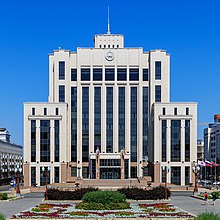
Tatarstan's unicameral State Council consists of 100 seats: fifty for representatives of the parties and fifty for deputies from the republic's localities. The Chairman of the State Council is Farit Mukhametshin, who has served since 27 May 1998. The government is the Сabinet of Ministers. The prime minister of the Republic of Tatarstan is Alexei Pesoshin.
According to the Constitution of the Republic of Tatarstan, the Rais can be elected only by the people of Tatarstan, but due to Russian federal law, this law was suspended for an indefinite term. The Russian law on the election of governors says they should be elected by regional parliaments and that the candidate for Rais can be presented only by the president of Russia.
In December 2022, regional lawmakers voted to change the title of the head of the republic from president to rais (an Arabic title for "leader"); lawmakers were expected to adopt new amendments to Tatarstan's constitution so that it would be in line with the 2020 amendments to the Constitution of Russia and a federal law in 2021 which abolished regional presidencies. The title of president was seen as the last remaining symbol of federalism following the centralisation reforms under Vladimir Putin.[55] Incumbent president Rustam Minnikhanov originally was to retain the title of president until his term expires in 2025 under transitional agreements, however he became Rais in February 2024.[56]
Political status
[edit]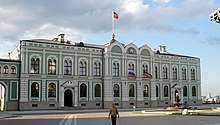
The Republic of Tatarstan is a constituent republic of the Russian Federation. Most of the Russian federal subjects are tied with the Russian federal government by the uniform Federal Treaty, but relations between the government of Tatarstan and the Russian federal government are more complex and are precisely defined in the Constitution of the Republic of Tatarstan. The following passage from the Constitution defines the republic's status without contradicting the Constitution of the Russian Federation:
"The Republic of Tatarstan is a democratic constitutional State associated with the Russian Federation by the Constitution of the Russian Federation, the Constitution of the Republic of Tatarstan and the Treaty between the Russian Federation and the Republic of Tatarstan On Delimitation of Jurisdictional Subjects and Mutual Delegation of Powers between the State Bodies of the Russian Federation and the State Bodies of the Republic of Tatarstan, and a subject of the Russian Federation. The sovereignty of the Republic of Tatarstan shall consist in full possession of the State authority (legislative, executive and judicial) beyond the competence of the Russian Federation and powers of the Russian Federation in the sphere of shared competence of the Russian Federation and the Republic of Tatarstan and shall be an inalienable qualitative status of the Republic of Tatarstan."[57]
Economy
[edit]

Tatarstan is one of the most economically developed regions of Russia. The republic is highly industrialised and ranks second to Samara Oblast in terms of industrial production per km2.[58]
In 2021, Tatarstan's gross regional product was €40 billion, while GRP per capita was €10,000.[59]
The region's main source of wealth is oil. Tatarstan produces 32 million tonnes of crude oil per year and has estimated oil reserves of more than 1 billion tons.[21][60] Industrial production constitutes 45% of the Republic's gross regional domestic product. The most developed manufacturing industries are petrochemical industry and machine building. The truck-maker KamAZ is the region's largest enterprise and employs about one-fifth of Tatarstan's workforce.[60] Kazanorgsintez, based in Kazan, is one of Russia's largest chemical companies.[61] Tatarstan's aviation industry produces Tu-214 passenger airplanes and helicopters.[21] The Kazan Helicopter Plant is one of the largest helicopter manufacturers in the world.[62] Engineering, textiles, clothing, wood processing, and food industries are also of key significance in Tatarstan.[58]

Tatarstan consists of three distinct industrial regions. The northwestern part is an old industrial region where engineering, chemical, and light industry dominate. In the newly industrial northeast region with its core in the Naberezhnye Chelny–Nizhnekamsk agglomeration, major industries are automobile construction, the chemical industry, and power engineering. The southeast region has oil production with engineering under development. The north, central, south, and southwest parts of the republic are rural regions.[63] The republic has huge water resources—the annual flow of rivers of the Republic exceeds 240 billion m3 (8.5 trillion cu ft). Soils are very diverse, the best fertile soils covering one-third of the territory. Due to the high development of agriculture in Tatarstan (it contributes 5.1% of the total revenue of the republic), forests occupy only 16% of its territory. The agricultural sector of the economy is represented mostly by large companies as Ak Bars Holding and "Krasnyi Vostok Agro".
The republic has a highly developed transport network. It mainly comprises highways, railway lines, four navigable rivers — Volga (İdel), Kama (Çulman), Vyatka (Noqrat) and Belaya (Ağidel), and oil pipelines and airlines. The territory of Tatarstan is crossed by the main gas pipelines carrying natural gas from Urengoy and Yamburg to the west and the major oil pipelines supplying oil to various cities in the European part of Russia.
Tourism
[edit]
There are three UNESCO world heritage sites in Tatarstan—Kazan Kremlin, Bulgarian State Museum-Reserve, and Assumption Cathedral and Monastery of the town-island of Sviyazhsk.[64]
The annual growth rate of tourist flow to the republic is on average 13.5%; the growth rate of the volume of services in the tourism sector is 17.0%.[65]
At the end of 2016, on the territory of the Republic of Tatarstan there were 104 tour operators, of which 32 dealt in domestic tourism, 65 in domestic and inbound tourism, 1 in domestic and outbound tourism, and 6 in all three.[citation needed]
As of 1 January 2017, 404 collective accommodation facilities (CSR) operate in the Republic of Tatarstan; 379 CSR are subject to classification (183 in Kazan, 196 in other municipalities of the Republic of Tatarstan).[66] 334 collective accommodation facilities received the certificate of assignment of the category, which is 88.1% of the total number of operating.
In 2016, special attention was paid to the development of tourist centres of the Republic of Tatarstan—Kazan, Bolghar, the town-island of Sviyazhsk, Yelabuga, Chistopol, and Tetyushi. The growth of tourist flow in the main tourist centres of the Republic compared to 2015 amounted to an average of 45.9%.

Currently, sanatorium and resort recreation is developing rapidly in Tatarstan. There are 46 sanatorium-resort institutions in the Republic of Tatarstan. The capacity of the objects of the sanatorium-resort complex of Tatarstan is 8847 beds; more than 4300 specialists are engaged in the service of residents. In 2016, more than 160 thousand people rested in the health resorts of the Republic of Tatarstan.[67] 22 health resort institutions of the Republic of Tatarstan are members of the Association of health resort institutions "Health resorts of Tatarstan," including 11 sanatoriums of PJSC "Tatneft."
Since 2016, the Republic of Tatarstan has been operating the Visit Tatarstan program, the official tourism brand of the Republic, the purpose of which is to inform tourists, monitor the reputation of the Republic, develop the tourism potential of the regions of Tatarstan, conduct market research, create partner projects with local companies, and expand internationally. "Tatarstan: 1001 pleasure" is the main message that tourists receive. The Visit Tatar website, where there is information about the main sights and recreation in Tatarstan, is available in 8 languages: Tatar, Russian, English, Chinese, German, Spanish, Finnish, and Persian.[68][69]
Tourist resources of historical and cultural significance
[edit]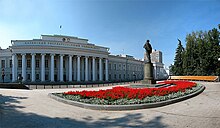

- Kazan Kremlin
- Kazan University
- Bolghar
- Sviyazhsk
- Temple of All Religions
- Qolşärif Mosque
- Saints Peter and Paul Cathedral
- Söyembikä Tower
- Millennium Bridge
- Old Tatar Quarter
- Galiaskar Kamal Tatar Academic Theatre
- The Jalil Opera and Ballet Theatre
- The National Museum of Tatarstan
Culture
[edit]Due to Islamic rules on artistic depictions,[70] Tatars developed a uniquely geometric artistry, of which the craft of leather mosaic is a staple.[71] They also observe certain pre-Islamic holidays, such as Sabantuy, which celebrates "the completion of spring sowing works."[70]
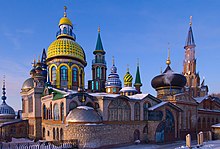

Major libraries include Kazan State University Nikolai Lobachevsky Scientific Library and the National Library of the Republic of Tatarstan. There are two museums of republican significance, as well as 90 museums of local importance. In the past several years, new museums appeared throughout the Republic.
There are twelve theatrical institutions in Tatarstan.[72] The state orchestra is the National Tatarstan Orchestra.[73]
In 1996, the Tatar singer, Guzel Ahmetova, cooperated with the German Eurodance group named Snap!, when she sang the lyrics of the song "Rame".[74][75]
Aida Garifullina was born in 1987 to a Tatar family in Kazan. Following studies in Nuremberg, Germany and Vienna, Austria, she has achieved fame as a lyric soprano, in high demand both on the international operatic stage and concert platform. She is also a celebrated recording artist and a promoter of the Tatar culture.[citation needed]
Sports
[edit]
With 9,175 sports venues in Tatarstan, the republic is one of the leading sports regions in Russia.[76] Since 1973, Kazan has been making efforts to expand its sports infrastructure, with sports being a "great source of pride" for the people of Kazan.[77]
Tatarstan has Rubin Kazan, a major European football team which has played in the UEFA Champions League and the UEFA Europa League. Twice Russian champions, Rubin Kazan play in the Russian Premier League. Also, Tatarstan has Unics Kazan which has gained a significant role in European basketball, playing in Euroleague and EuroCup for decades.
It also has two KHL teams, the successful Ak Bars Kazan, which is based in the capital city of Kazan, and the Neftekhimik Nizhnekamsk, who play in the city of Nizhnekamsk. The state also has a Russian Major League team (the second highest hockey league in Russia), Neftyanik Almetyevsk, who play in the city of Almetyevsk. There are also two Minor Hockey League teams which serve as affiliates for the two KHL teams. A team also exists in the Russian Hockey League, the HC Chelny, which is based in the city of Naberezhnye Chelny. Another team plays in the MHL-B (the second level of junior ice hockey in Russia).
Nail Yakupov is an ethnic Tatar who was drafted first overall in the 2012 NHL Entry Draft.
Former ATP No. 1 Marat Safin and former WTA number 1 Dinara Safina are of Tatar descent.
Victor Wild and Danil Sadreev are both Tatarstan Olympians, having won a bronze in parallel giant slalom and a silver in ski jumping, respectively.[78]
Kazan hosted the XXVII Summer Universiade in 2013, the FINA World championship in aquatic sports in August 2015, and the World Junior Championship for swimming in 2022.[79]
Education
[edit]The most important facilities of higher education include Kazan Federal University, Kazan State Medical University, Kazan National Research Technological University, World Information Distributed University, Kazan National Research Technical University named after A.N.Tupolev and Russian Islamic University. All of these are located in the capital city, Kazan.
Public spaces
[edit]Tatarstan takes a unique participatory approach to the development of public spaces that has earned it recognition. The Tatarstan Public Spaces Development Programme aims to create spaces for meeting or recreation.[80] The programme covers a wide spectrum of projects, including streets, squares, parks, river banks, pavilions, and sports facilities.[80]
Since 2016[80] (and continuing until 2022), the Architecturny Desant Architectural Bureau in Kazan[81] has improved public spaces in each of Tatarstan's 45 municipal districts, from large cities to small villages.[82] As of April 2019, the project had revamped 328 public spaces.[83] By creating and rehabilitating public spaces, the programme aims to be a catalyst for positive social, economic, and environmental change.[84]
One notable example is the "Beach" at Almetyevsk, which includes public swimming pools and a terrace.[80] Other examples include an amphitheatre in Black Lake Park, Kazan; the Central Square in Bavly; a children's playground in Bogatye Saby village, which has a unique wooden play structure; the Cube container centre in the green beach at Gorkinsko-Ometievsky forest, Kazan; and the square on Festival Boulevard, Kazan.[84]
The programme used an innovative participatory design approach,[85] which later became mandatory for similar projects across Russia.[84] This approach partners specialists with local residents at every stage of the project, from development, to implementation, to the ongoing use of the space.[85]
The Tatarstan Public Spaces Development Programme was announced as one of the six winners of the 2019 Aga Khan Award for Architecture.[86][87][88] The jury was impressed by the programme's systematic approach and involvement of residents to decide the future of each space.[85][89]
Each public space expresses the unique identity of that particular place,[84] tying in its history while incorporating traditional materials.[85] Major goals of the projects include improving the quality of life for residents and improving the environment.[85] The Arhitekturnyi Desant team aims to provide a high quality public space, no matter the size of the settlement, including quality design, infrastructure, and materials.[85]
Spending on the public spaces projects is helping the local economy.[when?][80] The number of street furniture manufacturers in the area, for example, has increased from 12 to 75 since the programme started.[80]
See also
[edit]- KAZANSUMMIT
- List of Chairmen of the State Council of Tatarstan
- List of rural localities in Tatarstan
- List of Tatars
- Music of Tatarstan
Notes
[edit]- ^ /ˈtɑːtərstæn/; Tatar: Татарстан [tɒtɒrˈstɑn]; Russian: Татарстан [tətɐrˈstan]
- ^ Tatar: Татарстан Республикасы, romanized: Tatarstan Respublikası; Russian: Республика Татарстан, romanized: Respublika Tatarstan, IPA: [rʲɪsˈpublʲɪkə tətɐrˈstan]
- ^ Tatar: Татария;[12][13][14] Russian: Татария
References
[edit]- ^ Президент Российской Федерации. Указ №849 от 13 мая 2000 г. «О полномочном представителе Президента Российской Федерации в федеральном округе». Вступил в силу 13 мая 2000 г. Опубликован: "Собрание законодательства РФ", No. 20, ст. 2112, 15 мая 2000 г. (President of the Russian Federation. Decree #849 of May 13, 2000 On the Plenipotentiary Representative of the President of the Russian Federation in a Federal District. Effective as of May 13, 2000.).
- ^ Law #2284, Chapter III
- ^ Госстандарт Российской Федерации. №ОК 024-95 27 декабря 1995 г. «Общероссийский классификатор экономических регионов. 2. Экономические районы», в ред. Изменения №5/2001 ОКЭР. (Gosstandart of the Russian Federation. #OK 024-95 December 27, 1995 Russian Classification of Economic Regions. 2. Economic Regions, as amended by the Amendment #5/2001 OKER. ).
- ^ Constitution of the Republic of Tatarstan, Article 122
- ^ Constitution of the Republic of Tatarstan, Article 9.2
- ^ "Указ Президента Российской Федерации от 12.07.2022 No. 445 ∙ Официальное опубликование правовых актов ∙ Официальный интернет-портал правовой информации". publication.pravo.gov.ru. Retrieved 2022-07-12.
- ^ Федеральная служба государственной статистики (Federal State Statistics Service) (2004-05-21). "Территория, число районов, населённых пунктов и сельских администраций по субъектам Российской Федерации (Territory, Number of Districts, Inhabited Localities, and Rural Administration by Federal Subjects of the Russian Federation)". Всероссийская перепись населения 2002 года (All-Russia Population Census of 2002) (in Russian). Federal State Statistics Service. Archived from the original on September 28, 2011. Retrieved 2011-11-01.
- ^ a b c Russian Federal State Statistics Service. Всероссийская перепись населения 2020 года. Том 1 [2020 All-Russian Population Census, vol. 1] (XLS) (in Russian). Federal State Statistics Service.
- ^ "Об исчислении времени". Официальный интернет-портал правовой информации (in Russian). Retrieved 19 January 2019.
- ^ Constitution of the Republic of Tatarstan, Article 8.1
- ^ Official throughout the Russian Federation according to Article 68.1 of the Constitution of Russia.
- ^ "РЕСПУБЛИКИ • Большая российская энциклопедия - электронная версия". bre.mkrf.ru. Retrieved 2022-03-17.
- ^ "Институт Татарской Энциклопедии –> Статьи энциклопедии". www.ite.antat.ru. Retrieved 2022-03-17.
- ^ Farnsworth, Beatrice (2002). "Village Mothers: Three Generations of Change in Russia and Tataria. By David L. Ransel. Indiana-Michigan Series in Russian and East European Studies. Bloomington: Indiana University Press, 2000. xii, 315 pp. Appendixes. Notes. Bibliography. Index. Photographs. Map. $39.95, hard bound". Slavic Review. 61 (2): 415–416. doi:10.2307/2697167. ISSN 0037-6779. JSTOR 2697167. S2CID 165075415.
- ^ a b Usmanov, Bulat; Nicu, Ionut Cristi; Gainullin, Iskander; Khomyakov, Peter (2018). "Monitoring and assessing the destruction of archaeological sites from Kuibyshev reservoir coastline, Tatarstan Republic, Russian Federation. A case study". Journal of Coastal Conservation: Planning and Management. 22 (2): 417–429. Bibcode:2018JCC....22..417U. doi:10.1007/s11852-017-0590-9. ISSN 1400-0350. S2CID 134991822.
- ^ "Tatarstan And Bashkortostan Become More Close". Executive Committee of World Congress of Tatars. December 23, 2010. Archived from the original on July 17, 2012.
- ^ "Meeting of two presidents". Administration of President of the Republic Tatarstan. August 16, 2011. Archived from the original on January 8, 2014. Retrieved July 19, 2012.
- ^ Whalley, Zita (May 31, 2018). "Will the Tatar Language Become Extinct?". Culture Trip. Retrieved 2020-12-25.
- ^ "Geographical Location". tatarstan.ru. Retrieved 2018-02-05.
- ^ a b Medvedeva, R. A.; Golosov, V. N.; Ermolaev, O. P. (2018). "Spatio-Temporal Assessment of Gully Erosion in the Zone of Intensive Agriculture in the European Part of Russia". Geography and Natural Resources. 39 (3): 204–211. Bibcode:2018GNR....39..204M. doi:10.1134/S1875372818030034. ISSN 1875-3728. S2CID 133846024.
- ^ a b c "Economy : The Republic of Tatarstan". September 24, 2006. Archived from the original on September 24, 2006.
- ^ DERRICK, MATTHEW A. "TERRITORY AND THE CHANGING SHAPE OF TATAR ISLAM IN TSARIST AND SOVIET RUSSIA | MATTHEW A. DERRICK | IJORS International Journal of Russian Studies". www.ijors.net.
- ^ Administrative-Territorial Structure of the Republic of Tatarstan, p. 3
- ^ Mizelle, Peter Christopher (2002). "Battle with Famine": Soviet Relief and the Tatar Republic 1921–1922. Retrieved 2016-12-31.
- ^ Suleymanova, Dilyara (2020). Pedagogies of culture: schooling and identity in post-Soviet Tatarstan, Russia. Anthropological Studies of Education Ser. Cham: Palgrave Macmillan. ISBN 978-3-030-27245-6.
- ^ "Declaration on the State Sovereignty of the Republic of Tatarstan". January 19, 2000. Archived from the original on January 19, 2000.
- ^ a b "Конституция Республики Татарстан : Республика Татарстан". September 25, 2006. Archived from the original on September 25, 2006.
- ^ a b United States. Congress. Commission on Security and Cooperation in Europe. (1992). Report on the Tatarstan referendum on soverignty [sic]: March 21, 1992, Kazan and Pestretsy. Washington, D.C.: The Commission.
- ^ "Заявились в Россию :: Общество :: Газета РБК". Rbcdaily.ru. 2014-03-17. Retrieved 2016-12-31.
- ^ "The Republic Of Tatarstan:TREATY BETWEEN THE RUSSIAN FEDERATION AND THE REPUBLIC OF TATARSTAN On Delimitation of Jurisdictional Subjects and Mutual Delegation of Authority between the State Bodies of the Russian Federation and the State Bodies of the Republic of Tatarstan". April 28, 1999. Archived from the original on April 28, 1999.
- ^ "Federation Council Backs Power-Sharing Bill". Radio Free Europe/Radio Liberty. 2007-07-11. Retrieved 2017-09-03.
- ^ "THE DECLARATION OF INDEPENDENCE OF TATARSTAN - CNN iReport". ireport.cnn.com. Archived from the original on 30 March 2014. Retrieved 17 January 2022.
- ^ Smirnova, Lena (2017-07-24). "Tatarstan, the Last Region to Lose Its Special Status Under Putin". The Moscow Times. Retrieved 2017-08-07.
- ^ Russian Federal State Statistics Service (2011). Всероссийская перепись населения 2010 года. Том 1 [2010 All-Russian Population Census, vol. 1]. Всероссийская перепись населения 2010 года [2010 All-Russia Population Census] (in Russian). Federal State Statistics Service.
- ^ Federal State Statistics Service (21 May 2004). Численность населения России, субъектов Российской Федерации в составе федеральных округов, районов, городских поселений, сельских населённых пунктов – районных центров и сельских населённых пунктов с населением 3 тысячи и более человек [Population of Russia, Its Federal Districts, Federal Subjects, Districts, Urban Localities, Rural Localities—Administrative Centers, and Rural Localities with Population of Over 3,000] (XLS). Всероссийская перепись населения 2002 года [All-Russia Population Census of 2002] (in Russian).
- ^ Всесоюзная перепись населения 1989 г. Численность наличного населения союзных и автономных республик, автономных областей и округов, краёв, областей, районов, городских поселений и сёл-райцентров [All Union Population Census of 1989: Present Population of Union and Autonomous Republics, Autonomous Oblasts and Okrugs, Krais, Oblasts, Districts, Urban Settlements, and Villages Serving as District Administrative Centers]. Всесоюзная перепись населения 1989 года [All-Union Population Census of 1989] (in Russian). Институт демографии Национального исследовательского университета: Высшая школа экономики [Institute of Demography at the National Research University: Higher School of Economics]. 1989 – via Demoscope Weekly.
- ^ "п≤п╫я┌п╣я─п╟п╨я┌п╦п╡п╫п╟я▐ п╡п╦я┌я─п╦п╫п╟". Gks.ru. Retrieved 2016-12-31.
- ^ "Каталог публикаций::Федеральная служба государственной статистики". Gks.ru. Retrieved 2016-12-31.
- ^ "Национальный состав населения". Federal State Statistics Service. Retrieved 30 December 2022.
- ^ "ВПН-2010". Perepis-2010.ru. Retrieved 2016-12-31.
- ^ Tatar The language of the largest minority in Russia, American Association of Teachers of Turkic, archived from the original on December 13, 2006, retrieved March 10, 2007
- ^ Tatars as Meso-Nation (PDF), Hokkaido University, retrieved 2007-03-10
- ^ "Казань. Электронная еврейская энциклопедия". Eleven.co.il. 2005-04-15. Retrieved 2016-12-31.
- ^ Altyntsev A.V., "The Concept of Love in Ashkenazim of Udmurtia and Tatarstan", Nauka Udmurtii. 2013. No. 4 (66), p. 131. (Алтынцев А.В., "Чувство любви в понимании евреев-ашкенази Удмуртии и Татарстана". Наука Удмуртии. 2013. No. 4. С. 131: Комментарии.) (in Russian)
- ^ Wertheim, Suzanne (September 2012). "Gender, nationalism, and the attempted reconfiguration of sociolinguistic norms". Gender and Language. 6 (2): 261–289. doi:10.1558/genl.v6i2.261.
- ^ a b "Main page project "Arena" : Non-profit research based consulting "Sreda"". Retrieved 2022-12-31.
- ^ a b 2012 Arena Atlas Religion Maps. "Ogonek", No. 34 (5243), 27/08/2012. Retrieved 21/04/2017. Archived.
- ^ Balkind, Nicole (2009). A Model Republic? Trust and Authoritarianism on Tatarstan's Road to Autonomy (MA).
- ^ "Tatarstan Parliament Introduces New Islam Holiday". Rferl.org. 2010-09-24. Retrieved 2016-12-31.
- ^ "Holiday Commemorating Arrival of Islam in Russia Ratified in Tatarstan". Islam Today. 2010-09-25. Archived from the original on 2010-09-30. Retrieved 2016-12-31.
- ^ "Religion". tatarstan.ru.
- ^ ""Orthodox monuments of Tatarstan" exhibition to be held in Kazan". Eng.tatar-inform.ru. Retrieved 2016-12-31.
- ^ "Today's Tatarstan in brief". September 30, 2000. Archived from the original on September 30, 2000.
- ^ Valeev, Denis (2011-11-22). "Islamic Graffiti Contest Held In Kazan". The Kazan Times. Archived from the original on 2016-03-06. Retrieved 2016-12-31.
- ^ "Russia's Tatarstan to Rename Regional Presidency". The Moscow Times. 23 December 2022.
- ^ "Tatarstan Lawmakers Vote To Change Constitution And Scrap Post of President In Nod To Moscow". Radio Free Europe/Radio Liberty}. 23 December 2022.
- ^ "KCFPP: The Constitution of the Republic of Tatarstan – New redaction of the Constitution of the Republic of Tatarstan of the 19th of April, 2002". Kazanfed.ru. Retrieved 2016-12-31.
- ^ a b "Tatarstan". Encarta. Archived from the original on November 1, 2009. Retrieved April 15, 2009.
- ^ "Валовой региональный продукт".
- ^ a b "TATARSTAN - Economy". April 24, 2001. Archived from the original on April 24, 2001.
- ^ lor08 (2016-02-18). "ПАО "Казаньоргсинтез"". Kazanorgsintez.ru. Retrieved 2016-12-31.
{{cite web}}: CS1 maint: numeric names: authors list (link) - ^ "Kazan Helicopter Plant (KHP) - Russian Defense Industry". January 13, 2001. Archived from the original on January 13, 2001.
- ^ Pirkko Suihkonen. "Call for papers: LENCA-2". Ling.helsinki.fi. Retrieved 2016-12-31.
- ^ "В Татарстане три исторических объекта признаны мировым достоянием" (Казанские Ведомости ed.).
- ^ http://tourism.tatarstan.ru/rus/file/pub/pub_857409.pdf Archived December 15, 2017, at the Wayback Machine Данные Государственного комитета Республики Татарстан по туризму за 2016 год
- ^ "Государственный комитет Республики Татарстан по туризму" (in Russian). tourism.tatarstan.ru. Retrieved 2017-12-21.
- ^ "Программа "Отдыхай в Татарстане" поможет развитию санаторных курортов" (РИА НОВОСТИ ed.). May 31, 2016.
- ^ "Разработка программы Visit Tatarstan обошлась в 2 млн. рублей". БИЗНЕС Online (in Russian). Retrieved 2017-10-12.
- ^ "Официальный туристический портал Республики Татарстан". visit-tatarstan.com. Retrieved 2017-10-12.
- ^ a b "Your Primer On Tatar Culture". The Moscow Times. 2018-06-01. Retrieved 2023-03-20.
- ^ "Leather Mosaic Technique". Unique Leather Mosaic. 2013-04-28. Retrieved 2023-03-20.
- ^ "Culture : The Republic of Tatarstan". September 24, 2006. Archived from the original on September 24, 2006.
- ^ "Tatarstan National Symphony Orchestra". tatarstan-symphony.com. Retrieved 2023-03-20.
- ^ "Snap! – Rame". YouTube. 5 May 2011. Archived from the original on 2021-10-30.
- ^ "Snap! – Rame (Гузель Ахметова Cover)". YouTube. 9 April 2011. Archived from the original on 2021-10-30.
- ^ "Sport". tatarstan.ru. Retrieved 2023-03-20.
- ^ Makarychev, A. S. (Andreĭ Stanislavovich); Yatsyk, Alexandra (2016). Mega events in post-Soviet Eurasia: shifting borderlines of inclusion and exclusion. Mega event planning. New York, NY: Palgrave Macmillan. ISBN 978-1-137-49095-7.
- ^ "Tatarstan sport minister about sports events in Kazan in 2022 — RealnoeVremya.com". realnoevremya.com. 2022-02-10. Retrieved 2023-03-20.
- ^ "Tatarstan sport minister about sports events in Kazan in 2022". realnoevremya.com. 2022-02-10. Retrieved 2023-03-20.
- ^ a b c d e f "Aga-Khan-Award: Die Plätze dem Volk in Tatarstan". Baublatt (in German). Retrieved 2019-08-28.
- ^ GmbH, BauNetz Media (2019-05-06). "Von Kinderdorf bis Fischmarkt - Shortlist des Aga Khan Award 2019". BauNetz (in German). Retrieved 2019-08-28.
- ^ "Shortlist for the 2019 Aga Khan Award for Architecture announced". Architectural Digest Middle East. Retrieved 2019-08-28.
- ^ "Three UAE Projects on 2019 shortlist for Aga Khan Award for Architecture". gulfnews.com. April 25, 2019. Retrieved 2019-08-28.
- ^ a b c d "Tatarstan Public Spaces Development Programme". www.akdn.org. Retrieved 2019-08-28.
- ^ a b c d e f "Программа развития общественных пространств в Татарстане поразила жюри премии Ага Хана системностью". www.tatar-inform.ru (in Russian). Retrieved 2019-08-28.
- ^ Woodyatt, Amy (2019-08-29). "Winners of prestigious Aga Khan architecture award announced". CNN Style. Retrieved 2019-08-31.
- ^ "ТОП-10 значимых событий в Татарстане за прошедшее 10-летие". sntat.ru (in Russian). Retrieved 2020-01-17.
- ^ "In Tatarstan, Russia, a Parks Program Creates Over 350 Public Spaces". Metropolis. 2020-01-21. Retrieved 2020-01-22.
- ^ Pitcher, Greg (April 26, 2019). "Two London practices shortlisted for Aga Khan Award". Architects Journal. Retrieved 2019-08-28.
Sources
[edit]- Закон №2284 от 14 июля 1999 г. «О государственных символах Республики Татарстан», в ред. Закона №23-ЗРТ от 18 марта 2013 г «О внесении изменений в Закон Республики Татарстан "О государственных символах Республики Татарстан" в части утверждения текста Государственного гимна Республики Татарстан"». Вступил в силу со дня опубликования (28 августа 1999 г.). Опубликован: "Республика Татарстан", No. 174, 28 августа 1999 г. (Law #2284 of July 14, 1999 On the Symbols of State of the Republic of Tatarstan, as amended by the Law #23-ZRT of March 18, 2013 On Amending the Part of the Law of the Republic of Tatarstan "On the Symbols of State of the Republic of Tatarstan" Adopting the Text of the State Anthem of the Republic of Tatarstan. Effective as of the day of publication (August 28, 1999).).
- 6 ноября 1992 г. «Конституция Республики Татарстан», в ред. Закона №79-ЗРТ от 22 ноября 2010 г. «О внесении изменений в статьи 65 и 76 Конституции Республики Татарстан». Опубликован: "Ведомости Верховного Совета Татарстана", №9–10, ст. 166, 1992. (November 6, 1992 Constitution of the Republic of Tatarstan, as amended by the Law #79-ZRT of November 22, 2010 On Amending Articles 65 and 76 of the Constitution of the Republic of Tatarstan. ).
- Госкомстат РФ. Государственный комитет Республики Татарстан по статистике. "Административно-территориальное деление Республики Татарстан" (Administrative-Territorial Structure of the Republic of Tatarstan). Казань, 1997.
Further reading
[edit]- Kropotkin, Peter Alexeivitch (1888). . Encyclopædia Britannica. Vol. 23 (9th ed.). pp. 70–71.
- Kropotkin, Peter Alexeivitch; Bealby, John Thomas (1911). . Encyclopædia Britannica. Vol. 15 (11th ed.). pp. 703–704.
- Ruslan Kurbanov. Tatarstan: Smooth Islamization Sprinkled with Blood OnIslam.net. Accessed: Feb. 26, 2013.
- Daniel Kalder. Lost Cosmonaut: Observations of an Anti-tourist.
- Ravil Bukharaev. The Model of Tatarstan: Under President Mintimer Shaimiev.
- Azadeayse Rorlich. The Volga Tatars: A Profile in National Resilience.
- Roderick Heather. Russia From Red to Black
- Matthew Reid. Shattered Kremlin: Echoes of the Iron Curtain
External links
[edit]![]() Media related to Tatarstan at Wikimedia Commons
Media related to Tatarstan at Wikimedia Commons
![]() Tatarstan travel guide from Wikivoyage
Tatarstan travel guide from Wikivoyage
- Official website of the Republic of Tatarstan
- Official website of the Republic of Tatarstan Archived July 17, 2011, at the Wayback Machine (in Russian)
- Official website of the Republic of Tatarstan Archived 2021-05-24 at the Wayback Machine (in Tatar)
- Tatar-Inform information agency
- Official Tourist Portal of the Republic of Tatarstan


